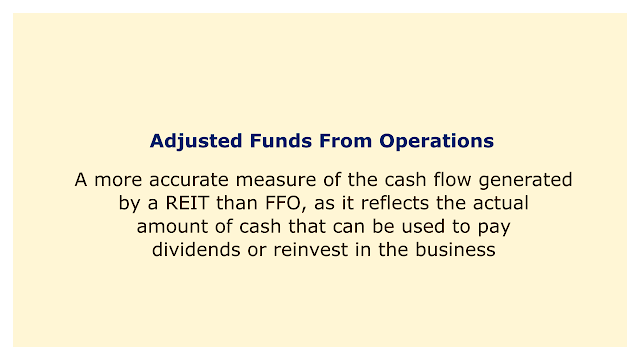 |
| Image: Moneybestpal.com |
Funds from operations (FFO) is one of the most crucial indicators for assessing the performance of real estate investment trusts (REITs).
FFO is a metric used to assess a REIT's operating cash flow, which is net of depreciation and amortization, profits or losses from property transactions, and other non-cash or irregular events. Investors and analysts frequently use FFO to evaluate a REIT's dividend payments for quality and sustainability as well as for growth possibilities.
FFO does not take into account some of the ongoing capital expenditures that are required to preserve and increase the value of the properties, so it is not a perfect measure of a REIT's cash flow condition. Tenant upgrades, leasing commissions, and facility repairs and upkeep are all part of these capital expenses. As a result, some REITs and analysts employ adjusted funds from operations, a modified version of FFO (AFFO).
AFFO is determined by deducting recurring capital expenditures from FFO and adjusting for other factors that may affect the cash flow accessible to shareholders, such as rent straight-lining, stock-based remuneration, and amortization of loan premiums or discounts. Since it reflects the actual amount of cash available for dividend payments or company reinvestment, AFFO is thought to be a more accurate indicator of the cash flow generated by a REIT than FFO.
The key benefit of utilizing AFFO instead of FFO is that it gives a more accurate picture of a REIT's underlying profitability and financial health. The elimination of some of the accounting variances and non-cash items that could skew the FFO calculations makes it possible to compare various REITs more meaningfully. By applying a multiple to an AFFO per share, investors and analysts can also use AFFO to determine a REIT's intrinsic value.
Unfortunately, there are several restrictions and difficulties in using AFFO. One of them is the lack of a common definition or acknowledged formula for calculating AFFO. It might be challenging to do an apples-to-apples comparison between REITs because they may calculate their AFFO numbers using various formulas or underlying assumptions. Moreover, some REITs may only report their AFFO data on an annual or quarterly basis, which decreases their openness and responsiveness. Moreover, AFFO might not account for all the variables that affect a REIT's cash flow, such as adjustments to working capital, changes in interest rates, or capital structure choices.
As a result, when assessing a REIT's performance or value, investors and analysts shouldn't rely simply on AFFO. Indicators and parameters like net income, revenue growth, occupancy rate, debt-to-equity ratio, dividend yield, and dividend payout ratio should also be taken into consideration. They can get a more complete and accurate picture of a REIT's strengths and shortcomings by using a variety of tools and techniques.
FFO does not take into account some of the ongoing capital expenditures that are required to preserve and increase the value of the properties, so it is not a perfect measure of a REIT's cash flow condition. Tenant upgrades, leasing commissions, and facility repairs and upkeep are all part of these capital expenses. As a result, some REITs and analysts employ adjusted funds from operations, a modified version of FFO (AFFO).
AFFO is determined by deducting recurring capital expenditures from FFO and adjusting for other factors that may affect the cash flow accessible to shareholders, such as rent straight-lining, stock-based remuneration, and amortization of loan premiums or discounts. Since it reflects the actual amount of cash available for dividend payments or company reinvestment, AFFO is thought to be a more accurate indicator of the cash flow generated by a REIT than FFO.
The key benefit of utilizing AFFO instead of FFO is that it gives a more accurate picture of a REIT's underlying profitability and financial health. The elimination of some of the accounting variances and non-cash items that could skew the FFO calculations makes it possible to compare various REITs more meaningfully. By applying a multiple to an AFFO per share, investors and analysts can also use AFFO to determine a REIT's intrinsic value.
Unfortunately, there are several restrictions and difficulties in using AFFO. One of them is the lack of a common definition or acknowledged formula for calculating AFFO. It might be challenging to do an apples-to-apples comparison between REITs because they may calculate their AFFO numbers using various formulas or underlying assumptions. Moreover, some REITs may only report their AFFO data on an annual or quarterly basis, which decreases their openness and responsiveness. Moreover, AFFO might not account for all the variables that affect a REIT's cash flow, such as adjustments to working capital, changes in interest rates, or capital structure choices.
As a result, when assessing a REIT's performance or value, investors and analysts shouldn't rely simply on AFFO. Indicators and parameters like net income, revenue growth, occupancy rate, debt-to-equity ratio, dividend yield, and dividend payout ratio should also be taken into consideration. They can get a more complete and accurate picture of a REIT's strengths and shortcomings by using a variety of tools and techniques.
